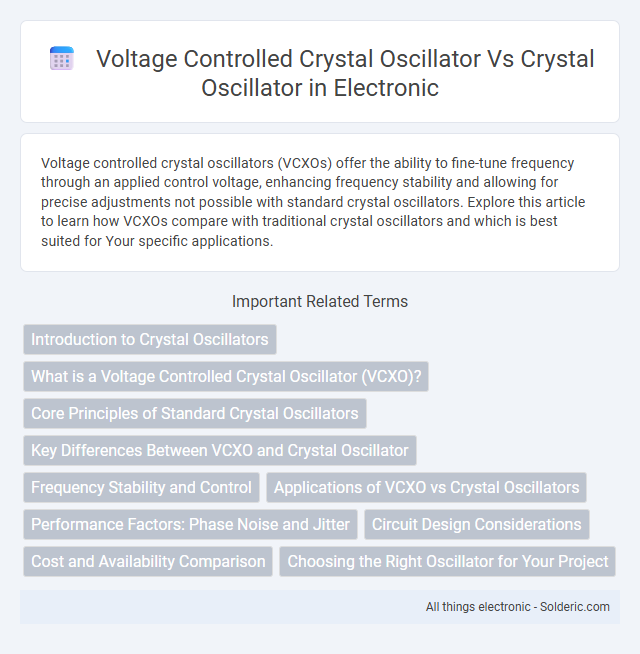Voltage controlled crystal oscillators (VCXOs) offer the ability to fine-tune frequency through an applied control voltage, enhancing frequency stability and allowing for precise adjustments not possible with standard crystal oscillators. Explore this article to learn how VCXOs compare with traditional crystal oscillators and which is best suited for Your specific applications.
Comparison Table
| Feature | Voltage Controlled Crystal Oscillator (VCXO) | Crystal Oscillator (XO) |
|---|---|---|
| Frequency Control | Voltage adjustable frequency within a narrow range | Fixed frequency determined by the crystal |
| Frequency Stability | High stability, slightly less than XO due to tuning | Very high, stable frequency output |
| Application | Frequency modulation, phase-locked loops, and timing adjustment | Precise clock generation, timing references in communication devices |
| Tuning Range | Small, typically +-100 ppm or less | None, fixed frequency |
| Complexity | More complex circuitry due to control voltage input | Simpler circuitry, no tuning elements |
| Cost | Higher cost due to additional control features | Lower cost, standard design |
Introduction to Crystal Oscillators
Crystal oscillators generate highly stable frequency signals using the piezoelectric properties of quartz crystals. Voltage Controlled Crystal Oscillators (VCXOs) enhance this stability by allowing fine frequency tuning through an applied voltage, making them ideal for applications requiring precise frequency adjustments. Your choice between a standard crystal oscillator and a VCXO depends on whether fixed frequency stability or adjustable frequency control is most critical for your system.
What is a Voltage Controlled Crystal Oscillator (VCXO)?
A Voltage Controlled Crystal Oscillator (VCXO) is a type of crystal oscillator whose output frequency can be finely adjusted by varying an applied control voltage, enabling precise frequency tuning within a limited range. Unlike a standard crystal oscillator, which provides a fixed frequency determined solely by the crystal, a VCXO combines the stability of a crystal with the flexibility needed for synchronization in communication systems and clock generation. Your circuit benefits from a VCXO when frequency modulation or phase alignment is required without sacrificing the inherent accuracy of crystal oscillation.
Core Principles of Standard Crystal Oscillators
Standard crystal oscillators operate based on the piezoelectric effect, where a quartz crystal vibrates at a fixed resonant frequency when an electric field is applied, providing a highly stable and precise frequency reference. The crystal's mechanical resonance controls the oscillator's frequency, making it less susceptible to temperature changes and mechanical stress. Your choice between a voltage controlled crystal oscillator and a standard crystal oscillator depends on whether frequency tuning capability is required, as standard crystal oscillators prioritize fixed, stable outputs.
Key Differences Between VCXO and Crystal Oscillator
Voltage Controlled Crystal Oscillators (VCXOs) differ from standard Crystal Oscillators by allowing frequency tuning through an applied control voltage, enabling precise frequency adjustment and compensation for environmental changes. Crystal Oscillators provide a fixed frequency output determined by the crystal's physical properties, ensuring high stability but without tunability. Your choice depends on whether you need a stable fixed frequency or a tunable frequency for applications like phase-locked loops or frequency modulation.
Frequency Stability and Control
Voltage controlled crystal oscillators (VCXOs) offer superior frequency control by allowing precise tuning of the output frequency through an applied voltage, making them ideal for applications requiring dynamic frequency adjustments. Standard crystal oscillators provide excellent frequency stability due to their high-quality quartz crystals but lack the ability to adjust frequency once fabricated. Your choice between these oscillators depends on whether strict frequency stability or tunable frequency control is more critical for your application needs.
Applications of VCXO vs Crystal Oscillators
Voltage Controlled Crystal Oscillators (VCXOs) are primarily used in telecommunications and precision frequency synthesis where fine frequency tuning and phase locking to a reference signal are required. Standard Crystal Oscillators excel in applications demanding stable, fixed frequencies such as timekeeping in clocks, microcontrollers, and consumer electronics. VCXOs enable dynamic frequency adjustment in phase-locked loops (PLLs) for synchronization within communication systems, whereas crystal oscillators provide a reliable, low-noise frequency source for various electronic devices.
Performance Factors: Phase Noise and Jitter
Voltage controlled crystal oscillators (VCXOs) offer superior phase noise and jitter performance compared to standard crystal oscillators due to their ability to fine-tune output frequency and maintain signal stability. Crystal oscillators provide a stable frequency reference with low phase noise but lack the frequency agility necessary to compensate for environmental variations, often resulting in higher jitter. Your choice of oscillator should consider VCXOs for applications demanding ultra-low phase noise and minimal jitter, such as high-speed data communication and precision timing systems.
Circuit Design Considerations
Voltage controlled crystal oscillators (VCXOs) require circuitry that integrates a varactor diode or similar component to enable frequency tuning through voltage control, necessitating careful biasing to maintain crystal stability. Crystal oscillator circuits prioritize minimizing noise and thermal drift, often employing fixed components and precise temperature compensation to ensure consistent frequency output. Your choice depends on design goals: VCXOs offer tunable frequency at the cost of increased circuit complexity, while standard crystal oscillators provide simplicity and stability.
Cost and Availability Comparison
Crystal oscillators are generally more cost-effective and widely available due to their simpler design and mass production in various standard frequencies. Voltage controlled crystal oscillators (VCXOs) have higher costs because of the additional voltage control circuitry, making them less common and more specialized in applications demanding frequency tuning. When selecting your oscillator, consider whether the added control precision of VCXOs justifies the increased price and potentially limited availability compared to standard crystal oscillators.
Choosing the Right Oscillator for Your Project
Voltage controlled crystal oscillators (VCXOs) offer precise frequency tuning through voltage adjustments, making them ideal for applications requiring fine frequency control such as phase-locked loops and frequency synthesis. Crystal oscillators provide stable, fixed frequencies with low phase noise and high frequency stability, suitable for clock generation and timing in microcontrollers and communication systems. Selecting the right oscillator depends on project requirements for frequency stability, tuning range, and phase noise performance to ensure optimal operation and signal integrity.
Voltage controlled crystal oscillator vs Crystal oscillator Infographic

 solderic.com
solderic.com